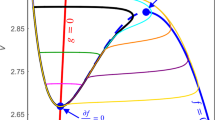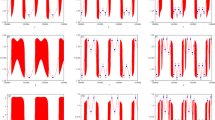Summary
-
1.
The circadian rhythm of pupal eclosion inSarcophaga argyrostoma was used as a “measure” of the phase of the covert photoperiodic oscillation in an experimental and formal analysis of photoperiodic induction, particularly in terms of entrainment and phase coherence within the multioscillator circadian system.
-
2.
Phase response curves for the eclosion pacemaker were obtained in single pulse resetting experiments for a series of pulse-lengths (1 to 20 h). These data were also analysed for “coherence” of the eclosion peaks in terms of Winfree's (1970) arrhythmicity or R-values.
-
3.
One and 3 h pulses of white light (240 μW cm−2) gave rise to “weak” or Type 1 resetting curves, whereas pulses of 5 h or more gave rise to “strong” or Type 0 curves. Pulses close to 4 h in duration starting at points close to 4 h after the transition fromLL to DD gave rise to highly arrhythmic eclosion patterns, suggesting that this combination of pulse duration and phase moved the system on to its “singularity.”
-
4.
Arrhythmicity was also observed in cultures in which the number of hours of darkness between theLL/DD transition and the beginning of the resetting pulse (D hours), and the duration of the pulse (L hours) added up to a value (D+L) close to 12, 36, 60, 84 or 108 h (modulo τ+1/2τ). Highly rhythmic cultures, however, were obtained when D+L added up to values close to 24, 48, 72, 96 or 120 h (modulo τ).
-
5.
The phase response curves for single 12 h pulses of white light were followed through the first 5 days of larval life. In the first two cycles following the transition fromLL to DD these pulses gave rise to strong (Type 0) curves; in subsequent cycles these curves “decayed” from Type 0 to Type 1. This change is thought to be associated with a developmental change, perhaps in the photoreceptor or its coupling to the “clock” or merely to a change in behaviour.
-
6.
The data obtained from phase response curves were used in a computer program to calculate steady-state entrainment to a variety of “complete” and “skeleton” photoperiods. These computed data were also compared with those experimentally determined for cultures exposed to identical regimes, and to diapause induction data obtained from earlier experiments.
-
7.
In “complete” photoperiods (T=24 h) the median of eclosion (φr) was shown to phase-lead dawn in cycles containing less than 14 h of light, but to phase-lag dawn in longer photoperiods. The point at whichφ r crossed the “dawn threshold” closely matched the value of the critical photoperiod for diapause induction. In symmetrical “skeletons” (T= 24 h) and asymmetrical “skeletons” (T=24 and 72 h) computed phases ofφ r, observed phases ofφ r, and diapause induction data were all in close agreement.
-
8.
The results are interpreted in terms of Pittendrigh's (1966) “external coincidence” model for the photoperiodic clock, the model which appears to offer the most plausible explanation for photoperiodic induction in this species. The model is modified, however, to incorporate the degree of internal organisation or disorganisation within the multioscillator circadian system. In particular, this accounts for the fall in diapause incidence in ultra-short daylengths, and for the results of “resonance” experiments.
-
9.
The “external coincidence” model, as adopted forS. argyrostoma, is compared with the formal properties of the photoperiodic clock in other insect species which have been adequately investigated. In particular, the strong similarities betweenS. argyrostoma and the aphid,Megoura viciae (Lees, 1973), are stressed.
Similar content being viewed by others
References
Adkisson, P.L.: Action of the photoperiod in controlling insect diapause. Amer. Nat.98, 357–374 (1964)
Beck, S.D.: Photoperiodic determination of insect development and diapause. I. Oscillators, hour-glasses, and a determination model. J. comp. Physiol.90, 275–295 (1974a)
Beck, S.D.: Photoperiodic determination of insect development and diapause. II. The determination gate in a theoretical model. J. comp. Physiol.90, 297–310 (1974b)
Beck, S.D.: Photoperiodic determination of insect development and diapause. III. Effects of non diel photoperiods. J. comp. Physiol.103, 227–245 (1975)
Beck, S.D.: Photoperiodic determination of insect development and diapause. IV. Effects of skeleton photoperiods. J. comp. Physiol.105, 267–277 (1976)
Bowen, M.F., Skopik, S.D.: Insect photoperiodism: The “T experiment” as evidence for an hour-glass mechanism. Science192, 59–60 (1976)
Bünning, E.: Die endogene Tagesrhythmik als Grundlage der photoperiodischen Reaktion. Ber. dtsch. bot. Ges.53, 594–623 (1936)
Bünning, E.: Common features of photoperiodism in plants and animals. Photochem. Photobiol.9, 219–228 (1969)
Hamner, K.C.: Photoperiodism and circadian rhythms. Cold Spr. Harb. Symp. quant. Biol.25, 269–277 (1960)
Hamner, W.M.: Diurnal rhythms and photoperiodism in testicular recrudescence of the house finch. Science142, 1294–1295 (1963)
Hamner, W.M.: Hour-glass dusk and rhythmic dawn dimers control diapause in the codling moth. J. Insect Physiol.15, 1499–1504 (1969)
Johnsson, A., Karlsson, H.G.: TheDrosophila eclosion rhythm, the transformation method, and the fixed point theorem. Department of Electrical Measurements, Lund Institute of Technology, Report No. 2/1972, November 15 (1972)
Lees, A.D.: The location of the photoperiodic receptors in the aphidMegoura viciae, J. exp. Biol.41, 119–133 (1964)
Lees, A.D.: Photoperiodism in insects. In: Photophysiology, Vol.IV. (ed. A.C. Giese), pp. 47–137. New York: Academic Press 1968
Lees, A.D.: Photoperiodic time measurement in the aphidMegoura viciae. J. Insect Physiol.19, 2279–2316 (1973)
Novak, V.J.A.: Insect hormones. 3rd Ed. London: Methuen & Co. 1966
Ottesen, E.A., Pittendrigh, C.S., Daan, S.: Entrainment of a circadian pacemaker by brief light pulses. II. A formal and experimental analysis, in preparation (1977)
Peterson, D.M., Hamner, W.M.: Photoperiodic control of diapause in the codling moth. J. Insect Physiol.14, 519–528 (1968)
Pittendrigh, C.S.: Circadian rhythms and the circadian organization of living systems. Cold Spr. Harb. Symp. quant. Biol.25, 159–184 (1960)
Pittendrigh, C.S.: On the mechanism of entrainment of a circadian rhythm by light cycles. In: Circadian clocks (ed. J. Aschoff), pp. 277–297. Amsterdam: North-Holland 1965
Pittendrigh, C.S.: The circadian oscillation inDrosophila pseudoobscura pupae: a model for the photoperiodic clock. Z. Pflanzenphysiol.54, 275–307 (1966)
Pittendrigh, C.S.: Circadian systems I. The driving oscillation and its assay inDrosophila pseudoobscura. Proc. Nat. Acad. Sci. (Wash.)58, 1762–1767 (1967)
Pittendrigh, C.S.: Circadian surfaces and the diversity of possible roles of circadian organization in photoperiodic induction. Proc. Nat. Acad. Sci. (Wash.)69, 2734–2737 (1972)
Pittendrigh, C.S.: Entrainment of a circadian pacemaker by brief light pulses. I. The empirical basis of a model, in preparation (1977)
Pittendrigh, C.S., Minis, D.H.: The entrainment of circadian oscillations by light and their role as photoperiodic clocks. Amer. Nat.98, 261–294 (1964)
Pittendrigh, C.S., Minis, D.H.: The photoperiodic time measurement inPectinophora gossypiella and its relation to the circadian system in that species. In: Biochronometry (ed. M. Menaker), pp. 212–250. Washington: National Academy of Sciences 1971
Saunders, D.S.: Circadian clock in insect photoperiodism. Science168, 601–603 (1970)
Saunders, D.S.: The temperature-compensated photoperiodic clock “programming” development and pupal diapause in the flesh-fly,Sarcophaga argyrostoma. J. Insect Physiol.17, 801–812 (1971)
Saunders, D.S.: Thermoperiodic control of diapause in an insect: theory of internal coincidence. Science181, 358–360 (1973a)
Saunders, D.S.: The photoperiodic clock in the flesh-fly,Sarcophaga argyrostoma. J. Insect Physiol.19, 1941–1954 (1973b)
Saunders, D.S.: Evidence for “dawn” and “dusk” oscillators in theNasonia photoperiodic clock. J. Insect Physiol.20, 77–88 (1974)
Saunders, D.S.: “Skeleton” photoperiods and the control of diapause and development in the flesh-fly,Sarcophaga argyrostoma. J. comp. Physiol.97, 97–112 (1975)
Saunders, D.S.: The circadian eclosion rhythm inSarcophaga argyrostoma: some comparisons with the photoperiodic clock. J. comp. Physiol.110, 111–133 (1976a)
Saunders, D.S.: Insect clocks. Oxford: Pergamon Press 1976b
Saunders, D.S.: The biological clock of insects. Sci. Amer.234, 114–121 (1976c)
Saunders, D.S.: Some differences between the photoperiodic clocks ofNasonia vitripennis (Hymenoptera, Pteromalidae) andSarcophaga argyrostoma (Diptera, Sarcophagidae), in preparation (1978)
Skopik, S.D., Bowen, M.F.: Insect photoperiodism: An hour-glass measures photoperiodic time inOstrinia nubilalis. J. comp. Physiol.111, 249–259 (1976)
Truman, J.W.: The role of the brain in the ecdysis rhythm of silkmoths: comparison with the photoperiodic termination of diapause. In: Biochronometry (ed. M. Menaker), pp. 483–504. Washington: National Academy of Sciences (1971)
Tyshchenko, V.P.: Two-oscillatory model of the physiological mechanism of insect photoperiodic reaction. Zh. obshch. Biol.27, 209–222 (1966)
Williams, C.M., Adkisson, P.L.: Physiology of insect diapause, XIV. An endocrine mechanism for the photoperiodic control of pupal diapause in the oak silkworm,Antheraea pernyi. Biol. Bull. Mar. Biol. Lab. Woods Hole127, 511–525 (1964)
Winfree, A.T.: Integrated view of resetting a circadian clock. J. theor. Biol.28, 327–374 (1970)
Winfree, A.T.: Slow dark-adaptation inDrosophila's circadian clock. J. comp. Physiol.77, 418–434 (1972)
Author information
Authors and Affiliations
Additional information
This work was supported by a grant from the Science Research Council. It is also a pleasure to thank Mrs. Helen MacDonald for technical assistance, and Dr. J.M. Deag for the computer program.
Rights and permissions
About this article
Cite this article
Saunders, D.S. An experimental and theoretical analysis of photoperiodic induction in the flesh-Fly,Sarcophaga argyrostoma . J. Comp. Physiol. 124, 75–95 (1978). https://doi.org/10.1007/BF00656393
Accepted:
Issue Date:
DOI: https://doi.org/10.1007/BF00656393




